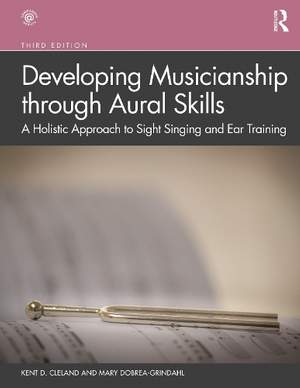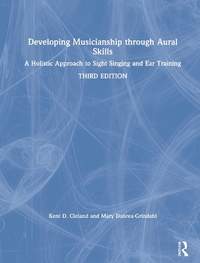
Developing Musicianship through Aural Skills: A Holistic Approach to Sight Singing and Ear Training
- Author: Cleland, Kent D.
- Author: Dobrea-Grindahl, Mary
Book
$140.75Contents
- Preface
- The Method
- Syllable Systems
- Reading in Clefs
- Module 1: Simple Meters
- Module 1a: Simple Beats and Their First Division and Multiple Note Values
- Module 1b: Simple Duple and Quadruple Meters
- Module 1c: Simple Triple Meters
- Module 1d: Second Division and Multiple of the Beat in Simple Meters
- Module 1e: Rests
- Module 1f: Ties and Dotted Rhythms in Simple Meters
- Module 1g: The Anacrusis
- Module 1h: Less Common Simple Meters
- Module 2: Major and Minor Scales and Scale Degrees
- Module 2a: Major Scales and Scale Degrees
- Module 2b: Minor Scales and Scale Degrees
- Module 3: Improvisation
- Module 3a: Introduction to Improvisation
- Module 3b: Methods for Improvisation and Improvising Tonic Function
- Module 3c: Improvising Dominant Function
- Module 3d: Improvising Predominant Function
- Module 3e: Improvisation Through Arpeggiation
- Module 4: Compound Meters
- Module 4a: Compound Beats and Their First Division and Multiple Note Values
- Module 4b: Second Division of the Beat in Compound Meter
- Module 4c: Less Common Compound Meters
- Module 5: Intervals
- Module 5a: Hearing and Singing Intervals Acontextually
- Module 5b: Major and Minor Seconds
- Module 5c: Major and Minor Thirds
- Module 5d: Perfect Fifths and Octaves
- Module 5e: Perfect Fourths
- Module 5f: Minor and Major Sixths
- Module 5g: Tritones
- Module 5h: Minor and Major Sevenths
- Module 6: Triads
- Module 6a: Hearing and Singing Acontextual Triads
- Module 6b: Root Position Major Triads
- Module 6c: Root Position Minor Triads
- Module 6d: Inverted Major and Minor Triads
- Module 6e: Diminished Triads
- Module 7: Seventh Chords
- Module 7a: Singing and Hearing Seventh Chords Acontextually
- Module 7b: Dominant Seventh Chords in Root Position
- Module 7c: Dominant Seventh Chords in Inversion
- Module 7d: Minor Seventh Chords
- Module 7e: Half-Diminished Seventh Chords
- Module 7f: Fully-Diminished Seventh Chords
- Module 7g: Major Seventh Chords
- Module 8: Common Diatonic Harmonic Progressions
- Module 8a: Cadences and Phrasing
- Module 8b: The TPDT Progression
- Module 8c: Circle of Fifths Progressions
- Module 8d: Filled-In Descending Thirds (Pachelbel) Progressions
- Module 8e: Ascending Sequential Progressions
- Module 9: Irregular Division and Syncopation
- Module 9a: Triplets
- Module 9b: Duplets
- Module 9c: Syncopation Within a Measure (Intra-measure Syncopation)
- Module 9d: Syncopation Across a Barline (Inter-measure Syncopation)
- Module 9e: Triplets in Augmentation and Diminution
- Module 9f: Other Divisions of the Beat
- Module 9g: Reading Complex Rhythms
- Module 10: Non-modulating Chromaticism
- Module 10a: The Chromatic Scale and Surface Chromaticism
- Module 10b: Modal Mixture
- Module 10c: Secondary Chords in the Major Mode
- Module 10d: Secondary Chords in the Minor Mode
- Module 10e: Neapolitan and Augmented Sixth Chords
- Module 10f: Extended, Added Note, and Altered Chords
- Module 11: Modulation
- Module 11a: Techniques for Modulation
- Module 11b: Modulation Between Relative Keys
- Module 11c: Modulation to the Dominant
- Module 11d: Modulation to Other Closely Related Keys
- Module 11e: Modulation to Distantly Related Keys
- Module 12: Changing Meter, Polyrhythm, and Asymmetric Meters
- Module 12a: Changing Meter
- Module 12b: Metric Modulation
- Module 12c: Polyrhythms and Polymeters
- Module 12d: Meters with Unequal Beats
- Module 13: Other Tonally Derived Scales
- Module 13a: Pentatonic and Blues Scales
- Module 13b: The Ecclesiastic Modes
- Module 13c: Synthetic Scales
- Module 13d: Polytonality and Polymodality
- Module 14: Post-tonal Music
- Module 14a: Whole Tone and Octatonic Scales
- Module 14b: Post-tonal Music
- Appendices
- Appendix A Glossary of Non-English Musical Terms
- Appendix B Using Your Voice: Suggestions for Vocal Production for Non-singers
- Index of Literature Examples
- Credits



